Every February the 2nd groundhogs get their 5 minutes of fame – before they are forgotten for the next 12 months.
If a groundhog gets out of its burrow and sees its shadow, it will retreat to its den, and winter will go on for six more weeks; if not, spring will arrive early. This is known as Groundhog Day in the US.
Groundhogs are some of the most unique and amazing animals in the whole animal kingdom. Most of the year, males will have no idea where the females are – they will only look for them when they are ready to mate. They are also known as woodchucks and belong to the group of large ground squirrels known as marmots.
The animals most similar to groundhogs are various species of marmots, prairie dogs, beavers, badgers, gophers, squirrels, and capybaras.
In this article, we will describe all of these animals that look like groundhogs so you know the difference.
Table of Contents
What Does A Groundhog Look Like?
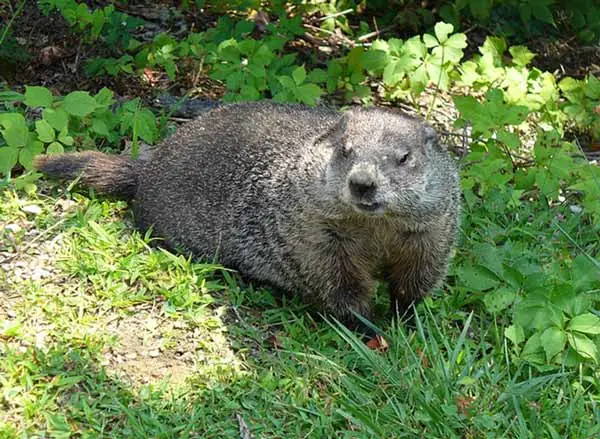
Groundhogs are small animals with yellowish-brown to black fur. They also have short legs and bushy tails.
These rodents have bodies that are compact and chunky – groundhogs also have long and curved claws for digging burrows on their feet.
Animals That Look Like Groundhogs
Marmots
Marmots are a large group of rodents that consists of 15 species (including groundhogs) living in Asia, Europe, and North America. All of these species are very closely related to groundhogs and therefore look very much alike.
All marmots have short legs, big claws they dig the ground with, heavy bodies, and large heads.
1. Alaska Marmot
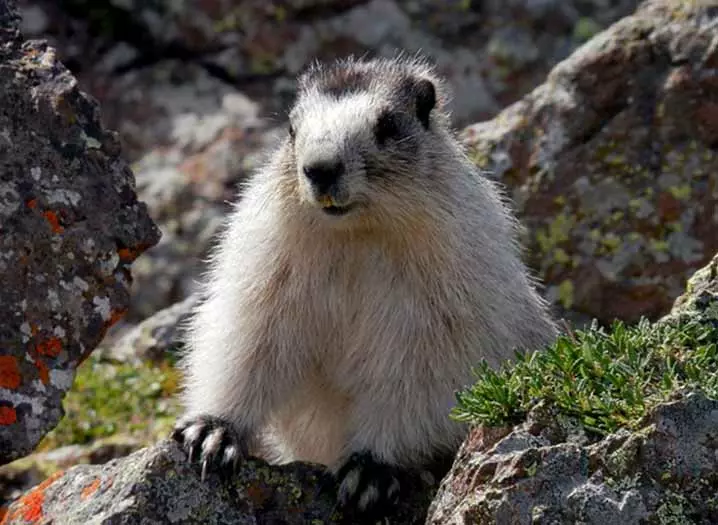
Scientific name: Marmota broweri
Size: 21-26 in
Weight: 5.5-8.8 lb
Found In: Alaska
The Alaska marmot is also known as the Brooks Range marmot. It is a big rodent that dwells underground. Alaska marmot, just like a groundhog, has a heavy body, short neck, bushy tail, big claws, and powerful legs and feet that are well-suited for digging.
Groundhogs are slightly smaller than Alaska marmots and have darker fur.
2. Alpine Marmot

Scientific name: Marmota marmota
Size: 17-21 in
Weight: 6.2-7.3 lb
Found In: Central and Southern Europe (Alps, Carpathians, Tatras, and Northern Apennines)
The alpine marmot is another large ground-dwelling squirrel that can be found in mountainous areas. It has a fur color running from blond and red, to dark gray. Alpine marmot has sturdy body, is an excellent digger, and hibernates up to 9 months per year.
They might have a similar build and fur color, but there are two main differences between a groundhog and an Alpine marmot: size and weight.
Alpine marmots are a couple of inches longer than groundhogs, have slightly longer tails, and can weigh almost 4 pounds more.
3. Black-Capped Marmot
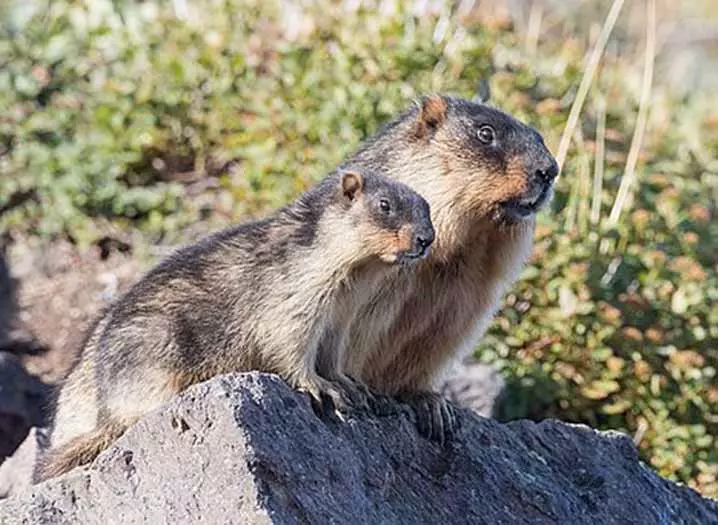
Scientific name: Marmota camtschatica
Size: 15.6–24.2 in
Weight: 3.6–11.9 lb
Found In: Siberia
Black-capped marmots are very social rodent species that live in the cold alpine areas of eastern Siberia and Kamtchatica. They are rather small marmots with short brownish-black tails, brownish-black caps on their heads, and cinnamon or rusty brown underparts.
As black-capped marmots get older, their color fades. These animals can be often seen lying on rocks or entering their burrows to eliminate heat.
Black-capped marmots share several physical similarities with groundhogs although being slightly smaller and lighter.
4. Bobak Marmot
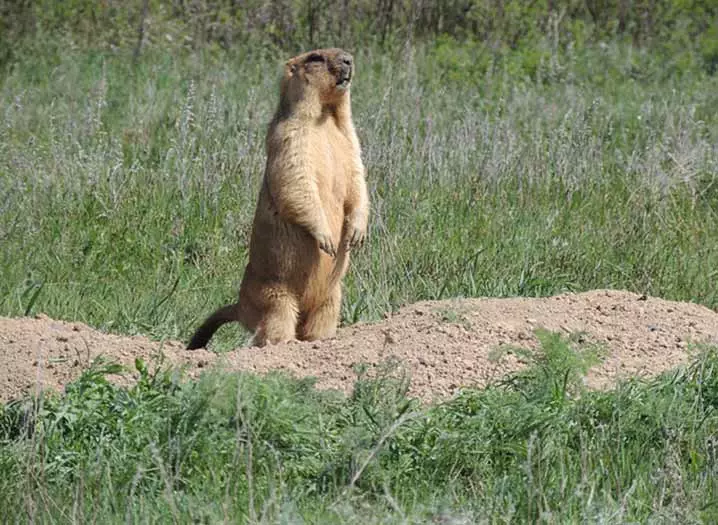
Scientific name: Marmota bobak
Size: 24 in
Weight: 11 lb
Found In: Eastern Europe and Central Asia
The Bobak marmot is also known as the steppe marmot. It is a species of marmot that lives in the steppes of Eastern Europe and Central Asia.
It is easy to spot while eating in the open grass; the Bobak marmot has a round stomach, short tail, and stubby legs, similar to its relative, the groundhog.
The main difference between the two is the Bobak’s smaller size, weight, and brighter brown fur color.
5. Forest-Steppe Marmot
Scientific name: Marmota kastschenkoi
Size: 18–26 in
Weight: 6.6 lb
Found In: Russia
The forest-steppe marmot is a rodent species that inhabit forest steppes of south-central Russia at altitudes from 590 to 1,480 ft. It hibernates for around 6 months.
Although it has a similar body length as the groundhog, the forest-steppe marmot can weigh almost 7 pounds more than the groundhog in the autumn before hibernation.
6. Gray Marmot Or Altai Marmot
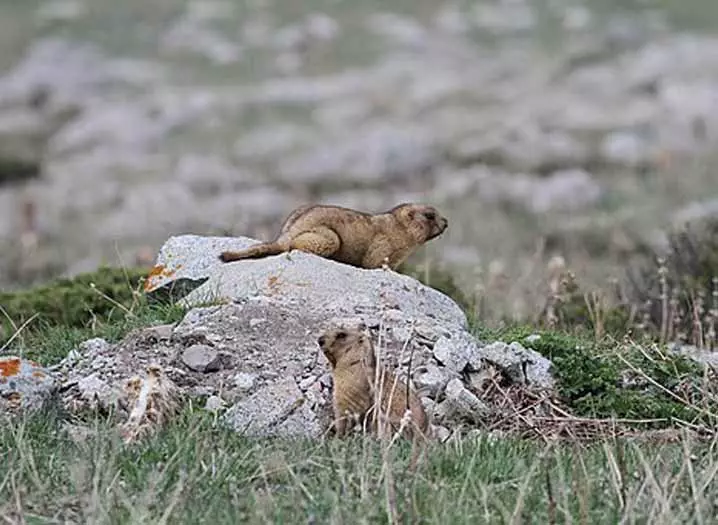
Scientific name: Marmota baibacina
Size: 25-30 in
Weight: 9-14.5 lb
Found In: Asia
The next animal similar to a groundhog is a gray marmot, also known as the Altai marmot.
It is one of the larger marmots that live in mountainous grasslands and shrublands of central Asia. Gray marmot has light greyish-brown fur covering the face and a short tail making it easy to confuse it for a groundhog.
Found in mountainous grasslands and shrublands of central Asia, these marmots may lose up to 30% of body mass during long seasonal hibernation.
Groundhogs may have slightly longer tails, but gray marmots can weigh up to 18 pounds before hibernation. And similarly to groundhogs, gray marmots have small round ears and love to dig extensive winter burrows for hibernation.
Gray marmots mostly feed on the sage bush in the spring and grasses and flowering plants in summer and fall.
7. Himalayan Marmot Or Tibetan Snow Pig

Scientific name: Marmota himalayana
Size: 18-26 in
Weight: 8.8-20.3 lb
Found In: Himalayas and Tibetan Plateau (Pakistan, northern India, Nepal, Bhutan, and China)
The Himalayan marmot is a marmot species that live in the grasslands of the Himalayas and on the Tibetan Plateau at altitudes between 9,800 and 18,000 ft.
It has a relatively large skull, big back feet, and long concave claws for burrowing. Himalayan marmot also has a yellow or brown color, often with black or blackish-brown spots on the face and snout.
Just like groundhogs, Himalayan marmots are members of the same squirrel family and have dense woolly furs. These marmots are one of the largest in the world and a lot bigger than groundhogs.
Very social animals, Himalayan marmots can form colonies of up to 30 families. These groundhog-like animals are herbivores and mostly feed on plants, grasses, berries, roots, and flowers.
8. Long-Tailed Marmot

Scientific name: Marmota caudata
Size: 15-31 in
Weight: 3.3–16.1 lb
Found In: Central Asia
The long-tailed marmot is also known as the golden marmot.
It lives in the open parts of central Asia and can be identified by a flattened head, short neck, strong claws, and long whiskers on cheeks, jaw, nose, and eyes.
Similar to a groundhog, the long-tailed marmot has small ears and large eyes close to the top of the head, to see above ground while remaining inside the burrow.
Long-tailed marmots have longer bodies than groundhogs, and as their name suggests a lot longer tails that can grow up to 11 inches long. As a comparison, groundhogs have a tail of around 7.3 inches.
They are monogamous, mate for life, and live in large social groups.
9. Menzbier’s Marmot
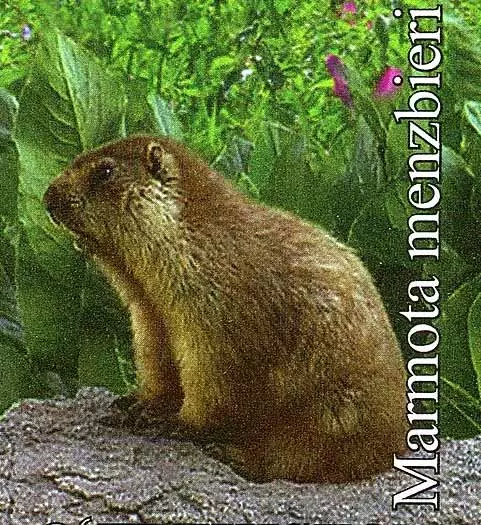
Scientific name: Marmota menzbieri
Size: 15 in
Weight: 6.6 lb
Found In: Central Asia
The Menzbier’s marmot is a rodent very similar to a groundhog that lives in Central Asia. It got its name from a Russian zoologist Mikhail Aleksandrovich Menzbier.
Menzbier’s marmot is a lot smaller than a groundhog and inhabits meadows and steppe at altitudes from 6,600 to 11,800 ft. Groundhogs, on the other hand, are mostly lowland animals.
It is the smallest of all marmots and can be recognized by dark upperparts and pale underparts and frontal parts. Menzbier’s marmot’s range often overlaps with one of long-tailed marmot.
10. Tarbagan Marmot
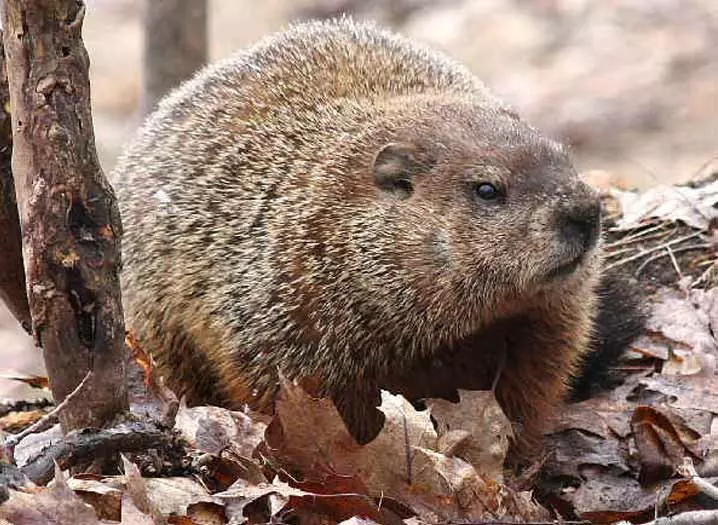
Scientific name: Marmota sibirica
Size: 20-23 in
Weight: 15 lb
Found In: Mongolia, China, and Russia
Tarbagan marmot is a rodent with a stout body and short limbs. It is easy to recognize by the medium-long brown fur and a bushy tail.
Tarbagan marmot prefers habitats with ample vegetation for grazing, such as grasslands, shrublands, mountain steppes, forest steppes, river basins, and valleys. It is found at altitudes ranging from 1960 ft to 9850 ft.
In the Mongolian Altai, the tarbagan marmot’s range overlaps with that of the Gray marmot.
Just like groundhogs, these marmots are herbivores and mostly feed on grasses.
11. Hoary Marmot

Scientific name: Marmota caligata
Size: 24-32 in
Weight: 8.3-15 lb
Found In: Northwestern North America
The hoary marmot is a large, bulky rodent that has short and heavy limbs, and a broad head. It has a white patch above its nose and usually has dark brown feet, resulting in the Latin name caligata, meaning “booted.”
Hoary marmot resembles a groundhog from distance, however, the two are easy to distinguish by the dark head with a white band across the face of this marmot. They also have longer bodies and tails than groundhogs.
Often nicknamed “the whistler”, the hoary marmot is the largest North American ground squirrel that will often emit a high-pitched warning to alert other members of the colony to possible danger.
It is a diurnal animal and a herbivore that mostly feeds on leaves, flowers, grasses, and sedges.
12. Olympic Marmot
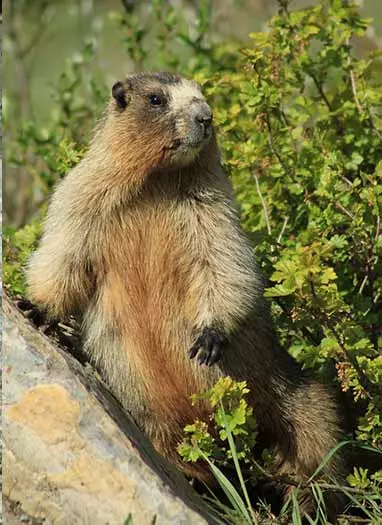
Scientific name: Marmota olympus
Size: 26-30 in
Weight: 6-24 lb
Found In: USA (Washington)
The Olympic marmot is a rodent that lives only in the U.S. state of Washington, on the Olympic Peninsula. It is the size of a cat and has a bushy tail.
The Olympic marmot resembles a groundhog but is slightly bigger and has a longer tail. You will recognize this animal by its wide head, small eyes and ears, and stubby legs.
Similar to a groundhog, it has sharp, rounded claws that help with digging burrows.
13. Vancouver Island Marmot
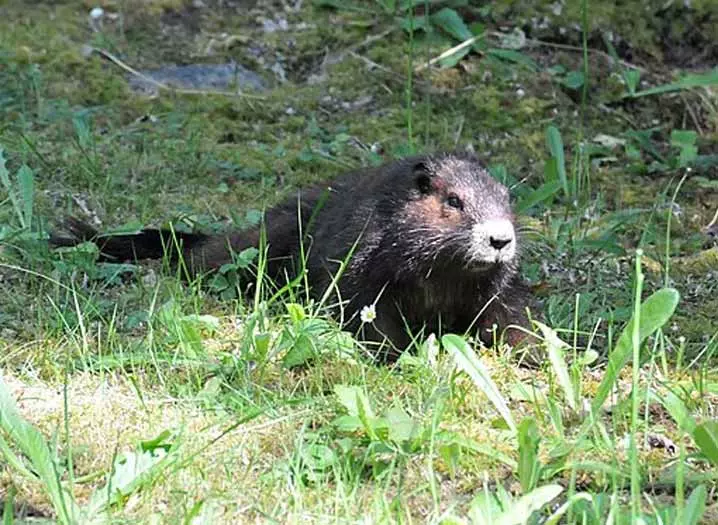
Scientific name: Marmota vancouverensis
Size: 18 in
Weight: 10 lb
Found In: Canada
The Vancouver Island marmot only exists in the high mountains of Vancouver Island, in British Columbia. It is also known as Canada’s panda.
Vancouver Island marmots live in burrows and feed on plants.
Although similar, Vancouver Island marmots can be easily distinguished from groundhogs by their rich, chocolate brown fur and contrasting white patches. These marmots are also shorter than groundhogs and have smaller tails.
Vancouver Island marmot is a critically endangered species, with less than 200 remaining in 2019.
14. Yellow-Bellied Marmot

Scientific name: Marmota flaviventris
Size: 16 in
Weight: 8.2 lb
Found In: USA and Canada
The Yellow-bellied marmot, also known as the rock chuck, has brownish fur, a yellow belly, and a white spot between the eyes. It has small round ears, a short white muzzle, and a black nose.
The yellow-bellied marmot has a similar length and bodyweight to a groundhog. Both of them are large, stout-bodied ground squirrels that belong to the same marmot genus.
Yellow-bellied marmots and groundhogs differ in their appearance, eating habits, mating, and social skills. These marmots like to live in the mountains and have paler color than woodchucks.
Yellow-bellied marmots also prefer to dig burrows under rocks, while groundhogs make their burrows under the soil.
Yellow-bellied marmot usually comes out of its burrow after sunrise, defecates, and then spends time grooming and sunning.
Prairie Dog
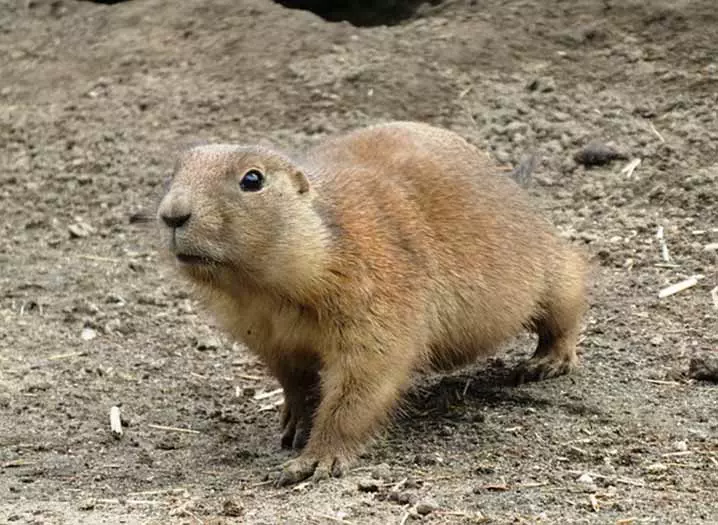
Scientific name: Cynomys
Size: 12-15 in
Weight: 1.5-3 lb
Found In: North America
The prairie dog is a large rodent that lives in the grasslands of North America.
Prairie dogs and groundhogs look similar and are related since they belong to the same family. Groundhogs and prairie dogs have similar body shapes and fur colors; the groundhog is significantly bigger.
You will differentiate these two animals by their size – prairie dogs are almost two to three times smaller than groundhogs.
Unlike groundhogs that like to live alone, prairie dogs will live in huge colonies.
In North America, prairie dogs mostly inhabit the western United States; groundhogs can be found in the eastern United States and Canada.
Read More: Animals that resemble prairie dogs – a lot!
Beaver
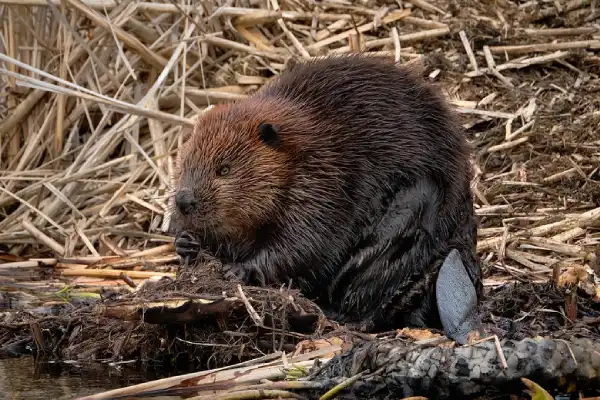
Scientific name: Castor
Size: 2.4-3.1 ft
Weight: 24-71 lb
Found In: USA, Canada, and Northern Mexico
Another animal that resembles a groundhog is a beaver. They’re both large rodents with brown fur, short limbs, and stocky bodies.
To distinguish one from the other, you would need to look at their weight and tails – beavers are almost 5 times heavier and have wide, flattened tails, while groundhogs have short, fluffy ones.
Beavers are romantic animals that mate for life with the whole beaver family living in a single dam.
If you ever saw one in person, you must have noticed the orange teeth. This isn’t due to poor dental hygiene.
Beavers’ tooth enamel contains iron, which makes the teeth very strong, sharp, and orange, allowing the animals to chew on trees.
Beavers like to build dams and live in ponds, lakes, rivers, and streams.
Read More: Animals That Live In Lakes
Badger
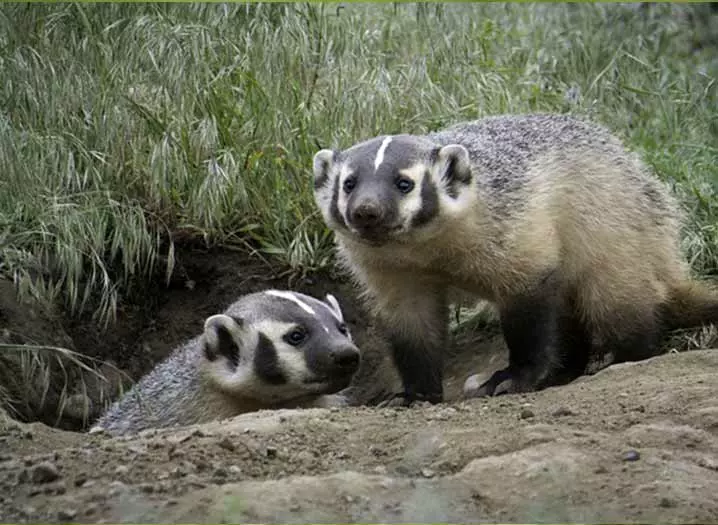
Scientific name: Meles meles
Size: 1.8–2.5 ft
Weight: 9-11 lb
Found In: North America
Badger is a short-legged heavily built omnivorous member of the weasel family, usually with gray and black coat color.
Badgers and groundhogs have similar body shapes – both are wide and stout with short legs. Badgers may also have relatively short and furry tails just like groundhogs, but they are almost twice the woodchucks’ size.
Despite both of them being local, grayish mammals that live in holes in the ground, groundhogs and badgers belong to different families.
As mentioned, badgers are hunting members of the weasel family (Mustelidae), while groundhogs are grazing members of the rodent family.
When it comes to color, groundhogs are generally a solid brown (not grizzled like the badger) and have no distinct markings on their face.
Capybara
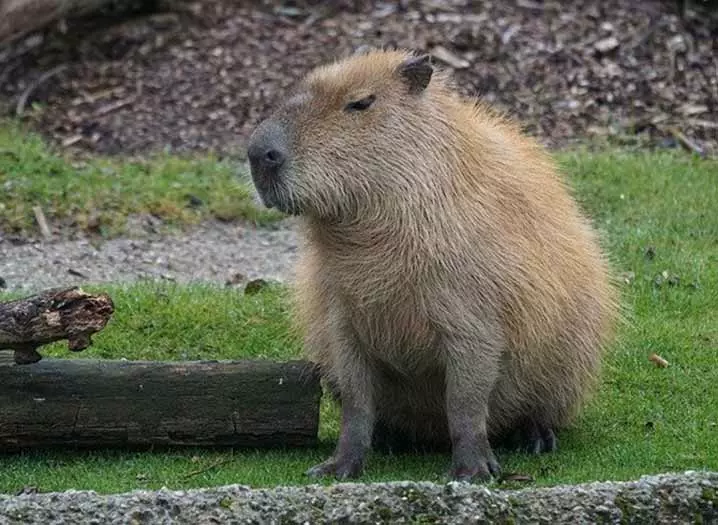
Scientific name: Hydrochoerus hydrochaeris
Size: 3.5-4.4 ft
Weight: 77-150 lb
Found In: South America
Capybara is an animal that looks like a large groundhog and is common around savannas, dense forests, and near bodies of water.
Just like groundhogs, capybaras have similar body shapes and dark-colored fur and use their long front teeth to chew plants and grasses and eat things like melons, fruits, and seeded plants.
Although they might look similar to woodchucks, capybaras do not have tails and weigh significantly more than groundhogs.
Capybaras are the world’s largest rodents found in South America – these highly social animals can be found in groups as large as 100 individuals.
Read more: 10 animals similar to meerkats
Gopher
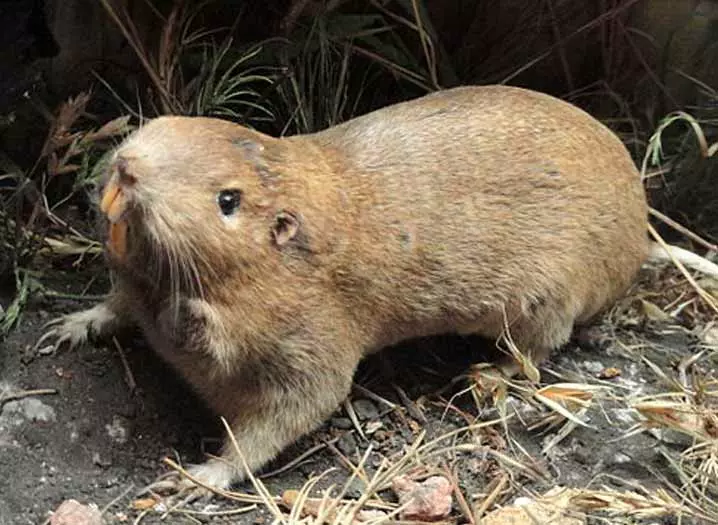
Scientific name: Geomyidae
Size: 6-8 in
Weight: 1-2.2 lb
Found In: Central America, USA, Canada
A gopher, also known as a pocket gopher, is a small rodent that weighs between 1 and 2.2 pounds. It mostly lives underground. There are around 41 species of gophers living in North and Central America and they got their name for their large, fur-lined cheek pouches.
Gophers and groundhogs have similar appearances and burrowing habits, they both live in underground tunnels and eat plants. They also have similar sharp teeth, nearly brown fur, and hibernate in the winter.
The main difference between gophers and woodchucks is the size, weight, and teeth color. Gophers are significantly smaller and lighter whereas groundhogs are larger and heavier.
Furthermore, gophers’ teeth are yellow and can be seen with their mouths closed; groundhogs have white teeth color that can only be seen when they open their mouth.
Read More: Is a javelina a rodent?
Ground Squirrel
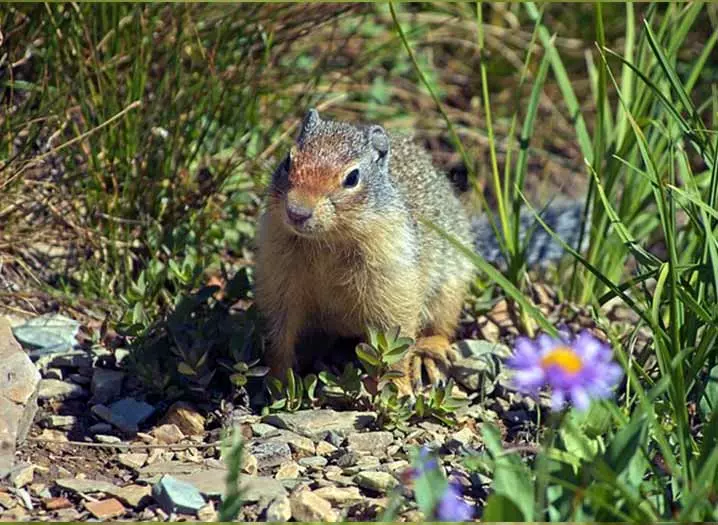
Scientific name: Marmotini
Size: 8-12 in
Weight: 1-3 lb
Found In: North America and northern Eurasia
Ground squirrel is a burrowing squirrel that lives on the ground rather than on trees. It is a highly social animal that can be found in North America and northern Eurasia.
The term “ground squirrel” refers to medium-sized ground squirrels, as the larger ones are more commonly known as marmots or prairie dogs, while the smaller and less bushy-tailed ground squirrels are known as chipmunks.
There are over 60 species of ground squirrels that have short legs, strong claws, small rounded ears, and a short or moderately long tail. Ground squirrels usually hibernate in winter.
A ground squirrel resembles a groundhog, both have long bodies, short front legs, and longer back legs.
Read more: Photos Of Animals With Huge Foreheads
Hyraxes
Hyraxes are small herbivorous animals that look like groundhogs. These herbivorous mammals have compact bodies and very short tails and can be found in arid countries in Africa and Arabia.
Although they resemble groundhogs, hyraxes are more closely related to elephants and sea cows. There are five species of hyraxes that exist today.
1. Rock Hyrax
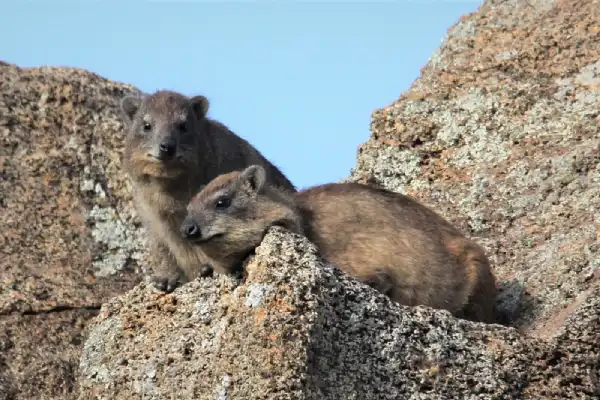
Scientific name: Procavia capensis
Size: 20 in
Weight: 8.8 lb
Found In: Africa and Asia
The rock hyrax is a small, furry, groundhog-like mammal that lives in rocky crevices in most parts of Africa and along the coast of the Arabian Peninsula up to Lebanon. It is called “dassie” in South Africa.
It is a social animal that lives in groups of 10 to 80 and is considered a pest in some parts.
The rock hyrax is easy to recognize by its thick and grey-brown fur, pointed head, short neck, and rounded ears – characteristics they share with groundhogs.
These animals are inactive 95% of the time and since they have incomplete thermoregulation, rock hyraxes use the environment to regulate their body temperature.
2. Yellow-spotted Rock Hyrax
Scientific name: Heterohyrax brucei
Size: 12-15 in
Weight: 5.5 lb
Found In: Africa
The yellow-spotted rock hyrax is a gregarious, colonial, and playful animal that can live in groups of dozens of individuals.
Although similar to groundhogs, yellow-spotted rock hyraxes are smaller, less heavily built, and have a narrower muzzle.
These animals are native to Africa and spend 80% of their foraging time browsing on twigs, leaves, buds, flowers, and forbs.
3. Tree Hyrax

Scientific name: Dendrohyrax
Size: 12-30 in
Weight: 6-7 lb
Found In: Africa
Tree hyraxes or tree dassies are small nocturnal mammals native to Africa.
These furry animals look like a cross between a groundhog and a ground squirrel – without the bushy tail. Their fur color ranges from a pale gray to light or dark brown and depends on the location – darker in wetter areas and lighter in more arid conditions.
Tree hyraxes might be more common than rock hyraxes, but they are very hard to spot due to their shy nature and nocturnal habits.
Muskrat
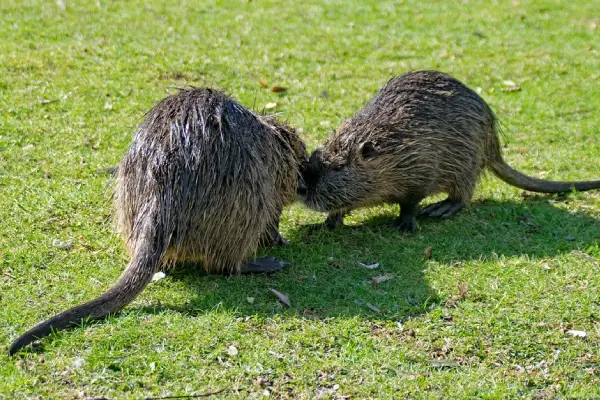
Scientific name: Ondatra zibethicus
Size: 8-10 in
Weight: 1.3-4.4 lb
Found In: North America, South America, Europe, and Asia
The muskrat is a medium-sized semiaquatic rodent native to North America.
Groundhogs and muskrats share physical similarities which makes it easy to confuse them with one another.
Both species are usually brown and stocky, with muscular builds. However, muskrats are much smaller and may range in color from white to black. Also, look at their tails – muskrats have hairless ones while woodchucks have thick, short, and furry tails.
Read More: List of buffalo lookalikes!
Wombat

Scientific name: Vombatidae
Size: 40 in
Weight: 44-77 lb
Found In: Australia
These short-legged, muscular marsupials are native to Australia. They have small, stubby tails, rodent-like front teeth, and powerful claws.
Despite inhabiting different continents, groundhogs and wombats share similarities. Both use their teeth to eat roots and other plants, have the same structure and type of teeth, and both excavate burrows.
The main difference is the size – wombats are much bigger and heavier than groundhogs. They are not related and belong to different families.
Final Thoughts
This concludes our article going over 25 animals similar to groundhogs.
Groundhogs are members of a group of 15 similarly-looking animal species called marmots. All of these animals have short and robust legs, huge digging claws, large heads, and incisor teeth. Animals that often get mistaken for woodchucks are prairie dogs, beavers, badgers, capybaras, gophers, and squirrels.
Further reading: List of animals similar to anteaters
Photo Credits
- Black-Caped Marmot – NadezhdaKhaustova, CC BY-SA 4.0 https://creativecommons.org/licenses/by-sa/4.0, via Wikimedia Commons (edited)
- Gray Marmot – Ron Knight from Seaford, East Sussex, United Kingdom, CC BY 2.0 https://creativecommons.org/licenses/by/2.0, via Wikimedia Commons (edited)
- Himalayan Marmot – Subhrajyoti Parida, CC BY 4.0 https://creativecommons.org/licenses/by/4.0, via Wikimedia Commons (edited)
- Long-tailed Marmot – Mvshreeram, CC BY-SA 4.0 https://creativecommons.org/licenses/by-sa/4.0, via Wikimedia Commons (edited)
- Menzbier Marmot – Post of Uzbekistan, Public domain, via Wikimedia Commons (edited)
- Tarbagan Marmot – https://www.mundoecologia.com.br/author/rafael/, CC BY-SA 4.0 https://creativecommons.org/licenses/by-sa/4.0, via Wikimedia Commons (edited)
- Vancouver Island Marmot – Alina Fisher, CC BY 4.0 https://creativecommons.org/licenses/by/4.0, via Wikimedia Commons (edited)
- Yellow Bellied Marmot – Jon Sullivan, Public domain, via Wikimedia Commons (edited)
- Pocket Gopher – Daderot, CC0, via Wikimedia Commons (edited)